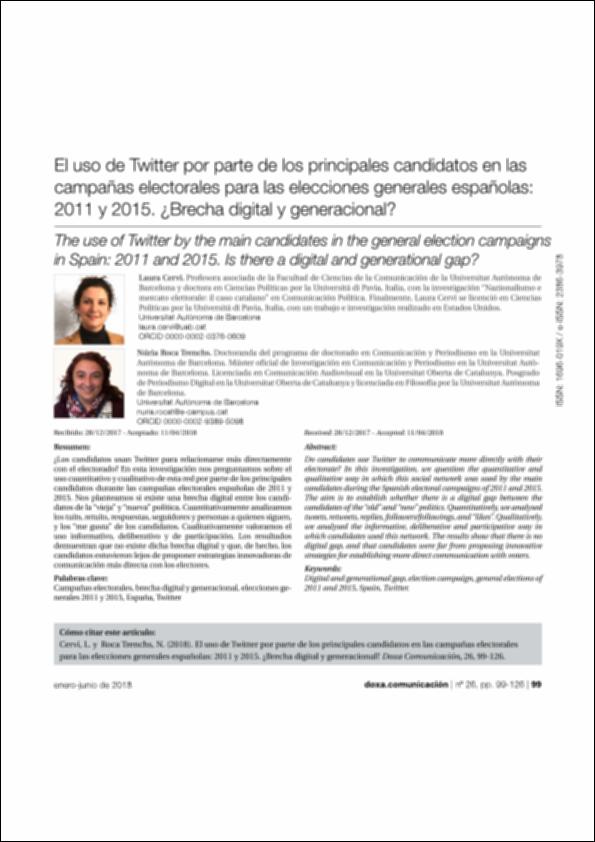Please use this identifier to cite or link to this item:
http://hdl.handle.net/10637/9459El uso de Twitter por parte de los principales candidatos en las campañas electorales para las elecciones generales españolas: 2011 y 2015 : ¿brecha digital y generacional?.

See/Open:
Uso_LauraCervi&NuriaRoca_Doxa_Comunic_2018.pdf
español
853,26 kB
Adobe PDF
See/Open:
Use_LauraCervi&NuriaRoca_Doxa_Comunic_2018_eng.pdf
english
675,04 kB
Adobe PDF
See/Open:
Uso_LauraCervi&NuriaRoca_Doxa_Comunic_2018.epub
español
2,01 MB
EPUB
See/Open:
Use_LauraCervi&NuriaRoca_Doxa_Comunic_2018.epub
english
1,41 MB
EPUB
| Title: | El uso de Twitter por parte de los principales candidatos en las campañas electorales para las elecciones generales españolas: 2011 y 2015 : ¿brecha digital y generacional?. |
| Other Titles: | The use of Twitter by the main candidates in the general election campaigns in Spain: 2011 and 2015: is there a digital and generational gap? |
| Authors : | Cervi, Laura Roca Trenchs, Núria |
| Keywords: | Campañas electorales; Brecha digital y generacional; Elecciones 2011 y 2015 |
| Abstract: | ¿Los candidatos usan Twitter para relacionarse más directamente con el electorado? En esta investigación nos preguntamos sobre el
uso cuantitativo y cualitativo de esta red por parte de los principales candidatos durante las campañas electorales españolas de 2011 y
2015. Nos planteamos si existe una brecha digital entre los candidatos de la “vieja” y “nueva” política. Cuantitativamente analizamos los tuits, retuits, respuestas, seguidores y personas a quienes siguen,y los “me gusta” de los candidatos. Cualitativamente valoramos el uso informativo, deliberativo y de participación. Los resultados demuestran que no existe dicha brecha digital y que, de hecho, los candidatos estuvieron lejos de proponer estrategias innovadoras de comunicación más directa con los electores. Do candidates use Twitter to communicate more directly with their electorate? In this investigation, we question the quantitative and qualitative way in which this social network was used by the main candidates during the Spanish electoral campaigns of 2011 and 2015. The aim is to establish whether there is a digital gap between the candidates of the “old” and “new” politics. Quantitatively, we analysed tweets, retweets, replies, followers/followings, and “likes”. Qualitatively, we analysed the informative, deliberative and participative way in which candidates used this network. The results show that there is no digital gap, and that candidates were far from proposing innovative strategies for establishing more direct communication with voters. |
| Description: | En: Doxa Comunicación: revista interdisciplinar de estudios de comunicación y ciencias sociales. e-ISSN 2386-3978 n. XXVI, 2018, pp 99-126 |
| URI: | http://hdl.handle.net/10637/9459 |
| Rights : | http://creativecommons.org/licenses/by-nc/4.0/deed.es |
| Issue Date: | 21-Jun-2018 |
| Center : | Universidad San Pablo-CEU |
| Appears in Collections: | Doxa.Comunicación nº 026 (2018) |
Items in DSpace are protected by copyright, with all rights reserved, unless otherwise indicated.

